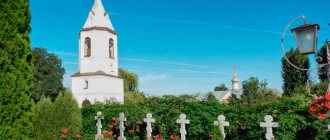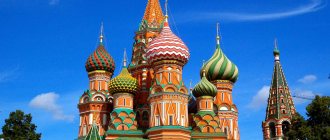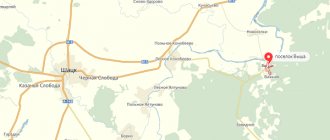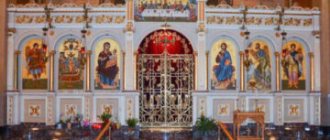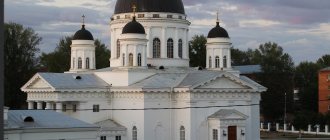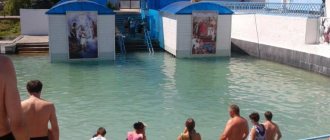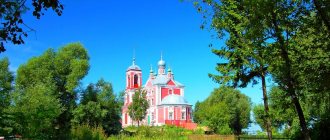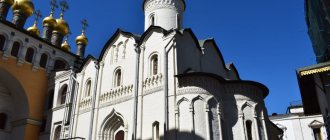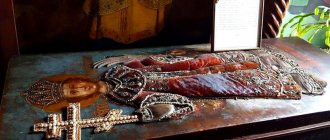| Voronezh Intercession Cathedral |
Voronezh Cathedral in honor of the Intercession of the Blessed Virgin Mary
, city cathedral of the Voronezh diocese
- Thrones: Intercession of the Most Holy Theotokos, Presentation of the Lord (right), icon of the Mother of God “The Sign” (left)
- Address: Russia, 394000, Voronezh, st. Bekhtereva, 36
- Tel. 55-53-80, 55-39-23
- Official site:
- On the map: Yandex.Map, Google map
The first mention of the Intercession Church is found in the “Watch Book” of Grigory Kireyevsky, dated 1615: “ The settlement of Belomestny atamans and Cossacks, and in the settlement there is a church in the name of the Intercession of the Blessed Virgin Mary, wood, dumplings, with a porch, and in the church there are images and bells and everything church building of the parish people
." The definition of “new” is not used in relation to it, so its appearance can be dated back to the beginning of the 17th century.
It is known that in 1700, Saint Mitrofan, the first bishop of Voronezh, gave a blessed charter for the construction of a new church, since the previous wooden church had fallen into disrepair. The original of this charter at the beginning of the 20th century was kept in the Church of the Intercession under glass in a wooden frame suspended from the middle left column of the refectory.
The wooden church stood for more than a century, and in 1736 the construction of a stone church began on this site. In 1748, the chapel was consecrated in the name of the Presentation of the Lord. At the end of the 18th century, a second chapel appeared in the temple, in the name of the icon of the Mother of God, called “The Sign,” it was consecrated on February 11, 1796 by Bishop Methodius (Smirnov) of Voronezh and Cherkassy.
In 1791, a low three-tier bell tower was built. One of its builders was stone mason Mikhail Spiridonovich Turchaninov. At the belfry, the largest of the bells, delivered from Moscow, weighed 181 poods 5 pounds (a little less than three tons).
Soon the need arose to rebuild the main temple, and on March 2, 1833, Archbishop Anthony (Smirnitsky) issued a new charter for the temple. The author of the design of the temple part could have been the provincial architect Ivan Andreevich Blitsyn (1781 - after 1841). It is known that the All Saints Church was built according to his design at that time, and its architecture has many similarities with the design of the dome of the Intercession. The main work was completed in 1835, but the finishing was delayed until 1841, and the church was consecrated on July 14, 1841 by Archbishop Anthony (Smirnitsky).
In 1839, the Little Russian Kuzma Safonov carried out “the renovation of two iconostases and all the icons of the church.” In 1847 and 1848, warm chapels were consecrated - in the name of the Presentation of the Lord and in the name of the icon of the Most Holy Theotokos, called “The Sign” - built in the refectory by the merchant S. P. Evfimov and “the diligence of the parishioners.”
Architecturally interesting is the priest's house, built next to the temple according to a “model” (standard) design at the beginning of the 19th century.
In the temple fence there was a small cemetery where the priests were buried - Grigory Grigoriev, Archpriest John Avsenev (1804-1892), who served in the temple for almost half a century, and Nikolai Egorov (1860-1904). Long-term church elders Longin Kirillovich Shashkov (1779-1858) and Vasily Onufrievich Ukhin, benefactor merchant Sergei Petrovich Evfimov (1784-1850), and merchant Tatiana Rodionovna Panina also rested here.
During the next renovation in 1872, “through the efforts of church warden V.O. Ukhina" both aisles were restored in the refectory, and the iconostases of the main church and the aisles were covered with red gold. The last time the church was consecrated after another renovation was on September 25, 1893 by Vicar Bishop Vladimir (Sokolovsky).
In 1904, the Intercession Church counted 1,282 people in its parish. The church staff consisted of two priests, one deacon, and two psalm-readers.
In the pre-revolutionary description of the cathedral, only a silver ladle, which Empress Anna Ioannovna granted to one of the Don Cossacks, was mentioned among things valuable in artistic or historical terms.
In 1921, valuables were confiscated from the Church of the Intercession to the fund of the famine-stricken Volga region (acts of confiscation were signed by priests John Putilin and Pavel Smirnsky. The church was closed and turned into a stable by the new government. In 1923, renovationists established themselves in the Church of the Intercession. The newly registered community was headed by Archpriest Vasily Izhogin.
In 1926, priests Pyotr Novoseltsev (1883 - 1937), Pavel Pashin and Pavel Smirsky (1873-1937) actively supported Archbishop Peter (Zverev) in his fight against the church schism.
In October 1927, it passed into the hands of the Gregorians: “ the autocephalists broke into the Intercession Church with impunity, broke open the royal doors in the altar, and expelled the Orthodox clergy
". In 1928, the Gregorian schism was led by Vissarion (Zornin) with the title of Archbishop of Voronezh and Zadonsk. The rector of the temple was Archpriest Alexy Popov, who previously served in the church of the Intercession Monastery. In 1930-1931 The Gregorian diocese was headed by Bishop Jerome (Baritsky), who was listed as the deputy of Metropolitan Vissarion of the Central Black Sea Region.
Divine services were held in the Church of the Intercession until May 1932, when the regional executive committee decided to seize the building from the community and transfer it to the House of Defense. Then an anti-religious museum was located in the temple.
In 1943, the building remained behind the Museum of Local Lore. It was restored according to the design of the architect Boris Nikolaevich Zotov (1896-1963).
Renaissance
In August 1945, the so-called “twenty” arose, led by Mikhail Pavlovich Vdovin and Fyodor Tikhonovich Khrenov, who began to petition for the return of the temple to believers. Twice these petitions were supported by Patriarch Alexy I with his appeals. On March 2, 1948, the Council for the Affairs of the Russian Orthodox Church decided:
«Satisfy the petition of believers to open the Church of the Intercession in the city of Voronezh and invite the commissioner of the Council under the Voronezh Regional Executive Committee to register the community and formalize the transfer of the church building and religious property to it
«.
On May 26, 1948, the building was transferred to the Orthodox community.
On October 14, 1948, on the patronal feast day, in front of a huge crowd of people, Bishop Joseph (Orekhov) of Voronezh and Lipetsk consecrated the Znamensky chapel in the refectory. The Church of the Intercession became a cathedral - the bishop's department was moved here from the St. Nicholas Church. Two purchased houses were restored in the churchyard, one of them became the residence of the bishop.
On October 7, 1951, after restoration, the cathedral was consecrated by Archbishop Joseph, concelebrated by 14 priests.
On November 23, 1952, a chapel in the church was consecrated in the name of St. Tikhon of Zadonsk.
Metropolitan Joseph (Orekhov) (1871-1961) was buried near the main altar.
Major repairs and renovation of the cathedral were carried out in 1961-1962 under Bishop Sergius (Petrov) of Voronezh and Lipetsk.
Since the late 1970s, construction of a drama theater began near the temple. The fencing of the work site came very close to the church yard. The bishop's residence and office were demolished.
On May 6, 1982, the 300th anniversary of the Voronezh diocese was solemnly celebrated in the Intercession Cathedral.
In 1982-1984, local authorities intended to demolish the cathedral; they managed to defend it thanks to Metropolitan Methodius (Nemtsov).
In 1989, the relics of St. Mitrophan of Voronezh were transferred to the cathedral.
From 2003 to 2012, a major restoration of the cathedral was carried out - communications in the temple were completely changed, the interior, carved iconostases, and icon painting were updated. Masters from Penza painted new frescoes and icons. Two small chapels in the refectory part of the temple have been updated.
On September 30, 2012, Metropolitan Sergius of Voronezh and Borisoglebsk, concelebrated by the vicar of the Voronezh diocese, Bishop Andrei of Ostrogozh, performed the great consecration of two renovated chapels of the Intercession Cathedral in the city of Voronezh - in honor of the Presentation of the Lord (southern aisle) and in honor of the Icon of the Mother of God “The Sign” (northern aisle) .
From 2014 to 2016, the bell tower was repaired and the external facades of the cathedral were restored, and in 2022 the adjacent buildings on the territory of the cathedral were restored.
On the territory of the Intercession Cathedral, a baptismal church in the name of the Holy Prophet, Baptist and Baptist John, the building of the Voronezh diocesan administration, a Sunday school, an icon painting school and Church Slavonic language courses for adults were built, and an Orthodox brotherhood was organized.
In the refectory located on the territory of the cathedral, the poor can receive a hot lunch.
Description of the architecture
Since the cathedral has gone through more than one restoration, many elements in its decoration were irretrievably lost. There are no small decorative details at all. The walls are plastered with a grainy texture. Their whiteness favorably emphasizes the richness of the golden domes.
The dome drum is cut through by high arched windows separated by pilasters. Due to this, the entire structure looks light, balancing the massive lower part. Despite numerous alterations, the cathedral is still a prominent representative of Godunov's classicism.
Interior of the Church of the Intercession in Voronezh
The interior decoration is represented by paintings depicting saints. Here you can see both saints of early Christianity and Voronezh ascetics. The passage to the refectory, decorated with painted plant motifs, is located on the east side.
The southern and northern aisles are equipped with choirs located in a recess. Spiral staircases along the edges lead to them.
How the church was almost moved
Uspenka experienced a real natural disaster after the Voronezh reservoir was filled in 1972. Water destroyed the fruits of restoration work.
– After the reservoir was filled, the groundwater level changed, the church essentially stood in a swamp. There were even reeds growing there. In order to remove the barrage of negative calls, we surrounded the temple with forests - it looks like it is being restored. But no one did anything. In this form, it stood for a very long time during Soviet times,” said the former chief architect of Voronezh, Leonid Yanovsky.
Photo – Mikhail Kiryanov
According to native Voronezh resident and local historian Oleg Kazanevsky, in the early 1980s they even wanted to move the church, which suffered from flooding. To do this, the famous Moscow architect Emmanuel Handel was invited from Moscow to Voronezh, who used a special technology to move the capital's houses - for example, the Savvinskoye Metochion. To separate the house from the foundation, a trench was dug around it and the building was cut off from the foundation using cables. In order for the house to “go,” a running frame was created for it, which was placed on rollers. The rollers moved on rails. Emmanuel Handel calculated the movement of the Assumption Church - it was planned to move it up the slope. But the city authorities abandoned this idea - apparently, the technology was too expensive.
Activities of the parish
As part of the work of the Orthodox association, spiritual educational conversations are carried out. For socially vulnerable segments of the population there is a refectory, where those in need are always fed a hot lunch. At school, those who wish have the opportunity to study icon painting in special classes.
There is a pilgrimage center at the cathedral, where you can find out interesting routes. For people with disabilities, a car is kept at the temple. Church Slavonic language courses are offered for adults. “Pokrovskoye Sisterhood” provides assistance to elderly people with disabilities.
The sisters visit boarding homes and orphanages. Under their leadership, excursions and meetings with the rector of the cathedral take place. There are currently 30 women in the organization.
The social department, headed by Archpriest Georgy, helps low-income citizens by organizing the distribution of things. In addition, the department accepts a professional lawyer for consultation.
Sunday school is attended by children aged 6 to 16 years. They study the Holy Scriptures, the Church Slavonic language, and become acquainted with the history of the Russian Church. The program includes all subjects that meet the standards of educational work in church schools in the country.
The Department of Childhood and Maternity takes care of patients at the City Children's Hospital. Here the communion of children is held, young parents are talked about how to raise and what to guide in this responsible matter. Clergymen also work with high school students, talking with them about questions that concern teenagers and to which they are embarrassed to ask their loved ones for answers.
The parish life of the cathedral is rich, which once again confirms its important role as the spiritual center of the city.
Temple of Alexander Nevsky (Voronezh)[edit]
The first temple founded in Voronezh after a long break was the church-chapel in the name of the holy noble prince Alexander Nevsky. The consecration of the construction site in the Northern District, at the intersection of Vladimir Nevsky and Marshal Zhukov streets, took place on February 6, 1993, performed by Archpriest Petr Petrov. The laying of the foundation stone for the temple-chapel took place in the summer of 1994. The project was carried out by architect Andrei Borisovich Logvinov. The care of the construction was entrusted to Archpriest Alexander Trunov.
In the summer of 1996, the work was completed, the first service took place on June 29, 1996. Metropolitan Methodius consecrated the temple-chapel on the patronal feast of St. Alexander Nevsky, September 12, 1996. The cross on the chapel was consecrated on April 15, 1997.
The church was built in the traditions of ancient Russian temple architecture. The shape of the temple’s base is “ship”. The temple is stone, whitewashed. The height to the cross is 13 m. There is no bell tower, only one dome. Assigned to the Church of Xenia of Petersburg.
Address:
Voronezh region, Voronezh city, Vladimir Nevsky street, building 48/1 building 2
Shrines and patronal feasts
For some time, a shrine with the relics of St. Mitrofan was kept in the Intercession Cathedral. It was moved to the Annunciation Cathedral in 2009. But an icon with a particle of his relics remained in the temple.
The main shrine of the Intercession Cathedral is the ark with a particle of the relics of St. Mitrofan, first bishop of Voronezh
Parishioners can also pray in front of the icons of St. Nicholas, Seraphim of Sarov, and Demetrius of Rostov. The Iveron Icon of the Blessed Virgin Mary was brought to the cathedral from Athos. She enjoys special love among believers. Spouses often come to her to ask for help and well-being for their family.
In 2004, emigrants from America and the Italian Countess del Borgo donated particles of the relics of the twelve apostles and an icon of St. Mitrofan to the Intercession Cathedral. The image was taken out of the country during Soviet times and was kept for a long time in the family of emigrants.
Since the cathedral was built in honor of the Intercession of the Most Holy Theotokos, its patronal feast day was established on October 14 , when the entire Orthodox world celebrates the feast of the same name. On this day, festive services are held, where the Intercessor of the Russian land is glorified.
History of construction
The Moscow governor Grigory Kireyevsky mentioned in his description of Voronezh the church in honor of the Intercession of the Most Holy Theotokos. Back in 1635, it was located on the territory of Myasnaya Gora. It is believed that this church is the predecessor of the modern golden-domed cathedral.
As time passed and the small church deteriorated, the need arose for its restoration. The priest and the parish turned to Bishop Mitrofan so that the bishop would bless them for work. The bishop soon responded to the appeal of his flock. Moreover, detailed instructions were created regarding what the new temple should become. In 1736, construction work began. The temple was built in stone; about 50 years were spent on construction.
In the XIX century. The parishioners felt crowded in the church and they again turned to the bishop with a request to bless them to create a new chapel. The bishop gave his blessing, and the Orthodox gathered the necessary funds. By the grace of God, a designer and an icon painter were found.
Intercession Cathedral in Voronezh
Updating buildings
The next renovation work was planned for 1833. At that time, Bishop Anthony was the archbishop. The parishioners turned to him for his blessing to work on the arrangement of the monastery. Two years later, the building was renovated, and finishing work was completed in 1841.
From the second half of the 19th century, more precisely, in the late 60s, charitable activities began in the temple. Almshouses were established where single and low-income women could find shelter and support. In 1893, a primary school for girls was founded.
Period of desolation
Before the onset of the post-revolutionary period, the life of the cathedral was peaceful and measured. But the Bolsheviks' rise to power brought destruction across the country. The Intercession Church did not escape the misfortune either. According to the program for the confiscation of temple valuables approved by the new government, the cathedral was looted. In 1923, a stable for the Red Army was built within its walls. Over time, the building was handed over to the renovationists.
Already in 1927, the temple passed into the possession of the Gregorians. In the 30s they were evicted, and the building was occupied by the House of Defense, which was replaced by the Anti-Religious Museum. He worked before the start of the Second World War. With the outbreak of the war, his property was removed from the temple. During the bombing and shelling, the cathedral was badly damaged, but did not collapse.
Archival photo of the temple complex
Restoration of the monastery
After the war, the monastery began to be restored. The work was completed in 1948, Christian parish life and divine services began. During the same period, the temple received the status of a cathedral. Another renovation was carried out in the 60s.
In the 70s, construction of a city drama theater began near the temple. They wanted to demolish the monastery. Vladyka Methodius, with God’s help, managed to save the ancient walls of the temple, but the authorities did not spare the bishop’s house and the broken garden.
In 1989, the relics of St. were transferred from the Local History Museum to the cathedral. Mitrofan. This event can be called decisive and turning point in the process of revival of the temple and all of Voronezh as a true Russian Orthodox city.
Currently, the cathedral is operational, although some restoration work is still carried out periodically. The Sacrament of Baptism is performed in a small church in honor of John the Baptist. A school and a vestibule storage facility were built separately. Now in the Voronezh diocese there are 3 cathedrals and 6 monasteries.
Schedule of services
Services for parishioners are held from Monday to Saturday from eight in the morning to seven in the evening. The evening service begins at 5:00 p.m. On Sundays services begin at 6:30. Liturgy is held at 8:00 on weekdays. On Sunday, the early Liturgy is celebrated at 6:30, the late Liturgy at 8:30.
Divine service in the Intercession Cathedral
On certain days, prayers are served to St. Mitrofan and akathists to the Mother of God are read. To find the current schedule of services for a specific day, just go to the official website of the cathedral.
Annunciation Cathedral (Voronezh)[edit]
By Resolution of the Executive Committee of the Voronezh City Administration dated August 7, 1998 No. 536, the Voronezh Diocesan Administration was allocated a plot of land in Pervomaisky Square on Revolution Avenue, where the construction of the Annunciation Cathedral began - in memory of the three largest and most beautiful cathedrals of the city, mercilessly destroyed by the atheistic authorities, and in a sign of repentance of Voronezh residents for godlessness and sacrilege.
The new cathedral in appearance repeats the Vladimir Cathedral of the city, erected in honor of the 900th anniversary of the Baptism of Rus', built in Voronezh by one of the followers of the famous architect K. Ton. The architectural design was carried out by V.P. Shevelev in the traditions of Russian-Byzantine architecture.
Address:
Voronezh region, Voronezh, Revolution Avenue 14 (Pervomaisky Square), Annunciation Cathedral
Telephone:
8 (473) 253-18-35
Kazan Church (Voronezh)[edit]
For centuries there has been a temple in Otrozhka in honor of the Kazan Icon of the Mother of God. The storms of the 20th century crashed against its stone walls, but it survived. The old temple has seen a lot in its time. And now, just like a hundred years ago, bells sound invitingly from its belfry every day, gathering believers to prayer.
According to historical information, Otrozhka (Rozhki, Atroshki, Otrozhki, Tregubovo) arose in the 17th century near the ledges, or “spurs” (hence the name), on the left bank of the Voronezh River. The settlement was assigned to the possessions of the Alexievsky Akatov Monastery and in 1629 there were only six peasant households. The most intensive development of Otrozhka took place in the 19th century, when several village blocks located along the only street began to be added to new ones in the eastern and southern directions along the road leading to Pridacha.
Address:
394021, Voronezh, st. Suvorova, 79
Telephone:
8 (473) 223-06-88; 8 (473) 223-05-95
St. Nicholas Church (Voronezh)[edit]
The Church of St. Nicholas the Wonderworker was built between 1712 and 1720, and, unlike many other churches in Voronezh, it was used almost all the time for its intended purpose. The history of St. Nicholas Church dates back to the beginning of the 17th century, when here, in Naprasnaya Sloboda, a wooden church was erected in honor of St. Dimitry Uglitsky.
In the Demetrius Church there was a revered miraculous image of St. Nicholas the Wonderworker. It was written no later than the middle of the 17th century; it was reported in the inscription on the ancient altar cross.
Address:
Russia, Voronezh, Taranchenko st., 19(a)
Telephone:
8(4732) 22-66-26
Elijah Church (Voronezh)[edit]
Elias Church
The first church on this site was erected, apparently, at the founding of the city. The current one was built in 1767-1770. In 1809, the future poet A.V. Koltsov was baptized in the church.
The church has been operating since 2000, but is still far from being fully restored. While clearing the area around the temple, a mass of human bones was discovered. It is believed that among them are the remains of those tortured by the Bolsheviks in 1918. To the left of the porch, a stone slab was placed in memory of the martyrs.
Address:
st. Sevastyanovsky Congress, 26
Temple of Blessed Xenia of Petersburg (Voronezh)[edit]
In 1995, not far from the chapel (now a temple) in the name of the holy noble prince Alexander Nevsky, a temple was founded in the name of Blessed Xenia of St. Petersburg, Christ the Holy Fool. Since 2000, active construction of the temple began, which continues. Currently, the small church of the Blessed Prince Alexander Nevsky and the lower church of St. Nicholas the Wonderworker are in operation. Three chapels will be created in the upper church: the main chapel in the name of Blessed Xenia of St. Petersburg, the right chapel in honor of the Pochaev Icon of the Mother of God, the left chapel in honor of the Vladimir Icon of the Mother of God.
The traditional religious procession from Voronezh to Zadonsk to St. Tikhon of Zadonsk visits the Church of St. Blessed Xenia of St. Petersburg, where a prayer service is performed and a meal is offered to pilgrims.
The temple is being built in the style of the ancient Russian tradition of temple architecture according to the design of the architect A. B. Logvinov. The shape of the temple’s base is “ship”. The temple will have nine domes, without a bell tower. The height of the temple is about 30 m. The belfry will be built in two small domes. Land plot - 1 hectare.
Address
: Voronezh, st. Zhukova, 15
Telephone:
74-45-38, 74-51-67
Assumption Admiralty Church (Voronezh)[edit]
Assumption (Admiralty) Church
Under Peter, all institutions that did not have a direct connection with ship construction were moved from the city center. The same fate befell the Assumption Monastery: in 1700 it was abolished, and the monks were moved to the Akatov Monastery. The main church of the Assumption Monastery, built in 1694, began to be used for the consecration of new ships. It was closest to the shipyards. This is how the church received its second name – Admiralty.
The temple was closed in 1940. From the outside it is one of the most beautiful temples in the city.
At the moment, the Assumption (Admiralty) Church of Voronezh is operational.
Address:
st. Karl Marx, 2.
Church of All Saints who shone in the Russian land (Voronezh)[edit]
The temple, dedicated to the intercessors and intercessors of our land, was erected in one of the most populated areas of the city - Sovetsky, which appeared on the map already in the godless years. There has never been a parish here before. The site given for the construction of the temple in the past belonged to a mechanical plant and was intended for the construction of the regional Palace of Pioneers, but in 1991 the authorities transferred the land to the Voronezh diocese.
At first, services were held in a converted railway carriage, then a temporary church was built (consecrated in October 1997). The temple became a spiritual center in a densely populated area of new buildings. Erection of crosses 05/23/2002
Address:
Russia, Voronezh, Domostroiteley street, 28
Telephone:
+7 (473) 278 82 80
